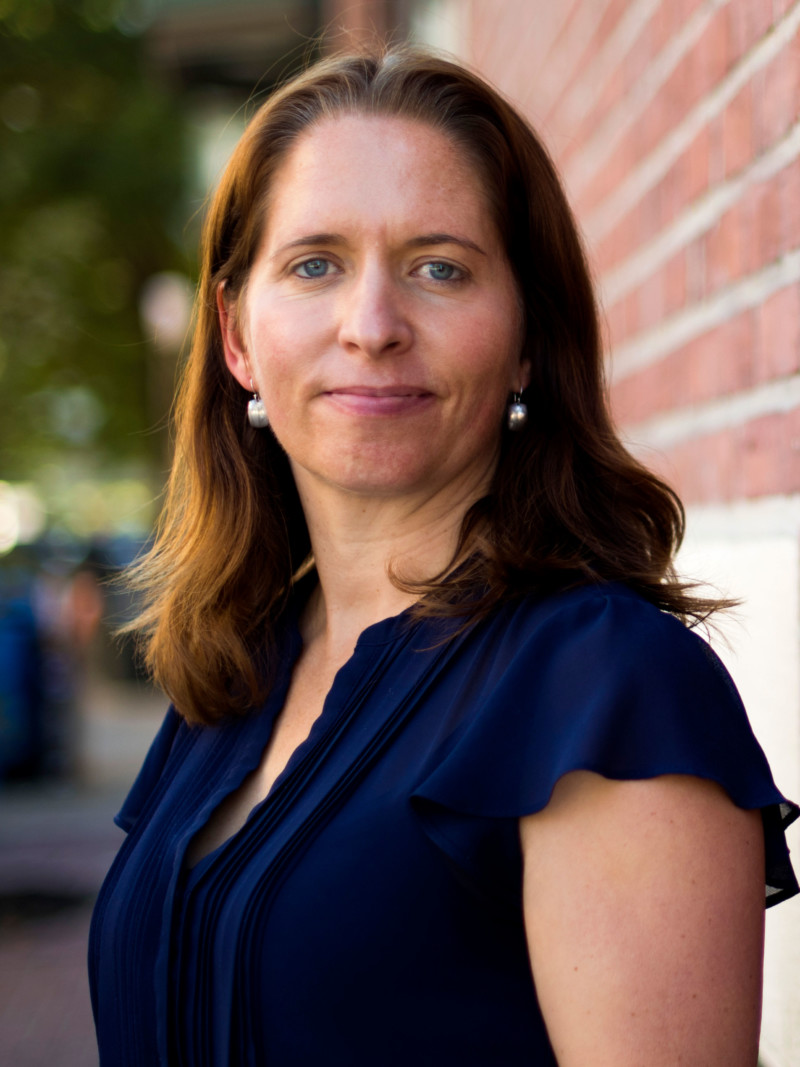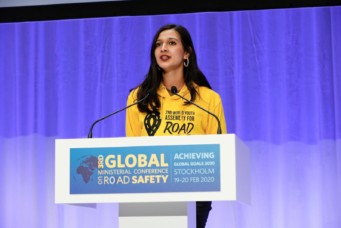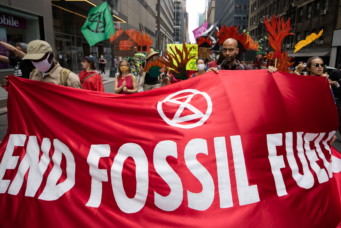All Policy is Climate Policy
Scholar and activist Jennie Stephens discusses the future of climate policy, emphasizing a “people-first” perspective and the need for larger societal structural transformation

Jennie Stephens. Photograph by Northeastern University.
Dr. Jennie Stephens is the Dean’s Professor of Sustainability Science and Policy at Northeastern University. She is also a feminist, scholar–activist, writer, and social justice advocate whose interdisciplinary work has articulated the need to move past “climate isolationism”—approaching climate change through a narrow technological lens— and into “climate justice,” which is beneficial to people and communities. The author of the 2020 book Diversifying Power: Why We Need Antiracist, Feminist Leadership on Climate and Energy, Stephens is a strong advocate of a “people-first” approach to climate policy, and she is critical of viewing climate change solely as a technological issue. Rather, her book refocuses the conversation around the transformative power that a feminist and anti-racist approach can leverage in climate and energy policy.
Stephens began her career in climate advocacy as an environmental scientist. Throughout her twenty-five-year career, Stephens began directing her research to the socio-political aspects of climate and energy policy after realizing that a technocratic approach to combating climate change was largely ineffective. Stephens argues that the most effective policy must come from leaders that recognize and work to resist the inequalities and disparities perpetuated by the pervading policies and structures of power. As the current climate leadership struggles to make progress in fossil fuel phaseout, the future must be rooted in the idea of energy democracy, which acknowledges the potential of redistributing wealth, power, jobs, and health more equitably as the world transitions to renewable energy. By utilizing a perspective that incorporates social justice, climate policy can encapsulate a larger structural transformation of society in order to be truly impactful.
Cairo Review Assistant Editor Ana Davis sat down with Dr. Stephens to discuss climate justice, the future of renewable energy, and her thoughts on COP27 and COP28.
CR: In the past, you’ve discussed extensively the intersections of class, race, and gender with climate change. Could you talk about what that connection is between climate action and social justice?
JS: It is becoming increasingly clear that the climate crisis is not the problem, but a symptom of a larger structural challenge. If we continue to focus narrowly on climate and say to ourselves, “oh, we need to fix the climate crisis,” we end up being ineffective. I think that is why we have been inadequate in our responses over the past couple of decades. So now, more of us are recognizing that the changes that are needed to address the climate crisis require deeper structural, economic, and financial changes that go way beyond greenhouse gas emission reductions in the energy system.
Most of my work has been on energy systems moving away from fossil-fuel-based energy systems toward renewable-based energy systems. But I see over and over again how so many clean energy policies end up advantaging rich people and corporations and excluding the most vulnerable people and households that are struggling. So I think we have very clear evidence at this point that the kind of narrow approach to climate ends up perpetuating and reinforcing injustices and increasing vulnerabilities of people, which is exactly the opposite of what we need to do. Embracing a climate justice lens, moving beyond a narrow technocratic view of the climate crisis, broadens out and calls for big investments in people and communities in all kinds of things beyond energy. Energy is critical, but investments in housing, food, education, and health are also needed, and are required if we are to be effective in reducing climate vulnerabilities.
CR: You’ve also written about looking beyond the idea of “climate isolationism,” and instead shifting to “climate justice.” You’ve also written about “diversifying power” which is discussed in a book by the same name. Could you explain these terms and describe how they might be applied to achieving more holistic and transformative climate action?
JS: I think it comes down to the fact that we really need bigger, transformative, structural, systemic change. So I was trained as an environmental scientist and started working on the climate issue from a scientific perspective where we focused on greenhouse gas emission reductions and technologies to reduce climate risk and climate impact. But throughout my career over the past twenty-five years, I’ve been increasingly aware of how that narrow technocratic lens which I call climate isolationism—thinking about the climate as a problem that needs to be fixed, and then coming up with technologies or narrow policies that focus only on trying to reduce greenhouse gas emissions—has just been completely ineffective. There are more renewables now than there were, but on the fossil fuel side, the fossil fuel companies and the countries that benefit most from fossil fuels have no plans to stop their fossil fuel extraction. So until and unless there is a global, collective initiative to constrain fossil fuel supply, we will not be moving in the right direction.
One of the reasons that climate policy has been ineffective for so long is that we have not been talking about fossil fuel phaseout, which has to be front and center. The Paris Agreement does not even explicitly mention fossil fuels, and COP27 didn’t mention oil and gas. Powerful interests have prevented genuine discussion on what needs to happen globally, which is fossil fuel phaseout. And climate isolationism, this narrow technocratic perspective, has fed into that delay strategy.
The other phrase that I use is climate justice—a term that really focuses on who’s benefiting, who’s being excluded, and where and why vulnerabilities are increasing. A climate justice lens considers that systems, policies, practices, and priorities are either perpetuating injustice and marginalization and vulnerability, or they are resisting, reversing, and repairing. A climate justice approach focuses on changing structures and relationships so we do not perpetuate the concentration of wealth and power and continue exploitative and extractive economic systems that maintain injustice. Climate justice focuses on investing in people and communities to resist continued marginalization.
Compared to more narrow climate action that focuses solely on emissions reductions, climate justice is a much more holistic approach. Climate justice means investing in people and communities around the world in a more equitable way, so that people are not as vulnerable to the disruptions that are now inevitable with climate change. There is a massive need to expand investment—big public investment in education, food systems, and health systems. There’s been a gradual complacency growing, a kind of acceptance of people not having their basic needs met, which I think is completely unnecessary and unacceptable. It’s an issue of more equitably distributing resources and recognizing that our current structures have not incentivized investing in the ways that we need to. Unfortunately the inequities and disparities have been getting worse rather than better. Last year in 2022, many of the fossil fuel companies made their biggest profit ever, while billions of people are struggling more than before. So I think that’s a big piece of what climate justice is about.
In my book, I explore climate isolationism, and the reason it is perpetuated. This has to do with who’s involved—and a lack of diversity. Conventional, male-dominated, patriarchal approaches to climate assume technology can “fix the climate”. This perspective assumes control over the climate system. But when we have more diversity of perspectives and experiences included in our processes, different policies are prioritized. I encourage feminist anti-racist leadership, which is an invitation to all of us to change the systems that advantage some while marginalize others. We don’t just need women to consider themselves feminist leaders, and we don’t just want people of color to consider themselves anti-racist leaders. We need leadership that acknowledges the power structures and the systems and policies and practices that perpetuate disparities and injustices at every level and on lots of different scales. In the book, I highlight many innovative, creative, diverse leaders who are doing amazing things that are connecting climate and energy to economic justice, food justice, health, and transportation justice. There is so much going on at a grassroots level that we don’t hear about—the book is an attempt to showcase some of the innovative and creative leaders and inspire people to get involved at different levels.
CR: Speaking about international climate policy, a lot of the indicators that we see coming out of these big conferences for measuring progress are very much based in numbers and seem to take more of the technocratic perspective that you discussed. So with a framework of climate justice, what indicators can we look to when assessing our progress that could help us look beyond isolationism?
JS: Great question, and there are a lot of different metrics to assess whether, if, and how we’re reducing climate vulnerabilities. Metrics of human well-being, in terms of health and education metrics, and metrics that show moving toward more healthy and equitable societies are indicators we can look at. If we consider the sustainable development goals, with many of those goals, we’re actually going in the wrong direction. The narrow focus on greenhouse gas emissions obfuscates responsibility for what’s happening in people’s lives and how the concentration of wealth and power is increasing. So I think metrics focused on the distribution of human wellbeing are important in a climate justice framework.
Another problem with focusing only on greenhouse gas emission reductions is the legitimization of market-based mechanisms, including carbon credits, that actually don’t have integrity, which then devalues the whole approach. It’s emerging that some organizations are buying credit to claim benefits now for saving some forest ten years ago. There’s all kinds of complicated and questionable approaches with the market-based mechanism that just focuses on carbon and emission reductions, and it’s really missing the point and delaying the transformative changes that are needed. This approach ends up reinforcing systems that do not value and incentivize investing in people and communities. Focusing more explicitly and clearly on people, a people-first approach, rather than the abstraction of greenhouse gas emissions is critically important. An additional metric that could be useful is tracking the supply of fossil fuels. Are we reducing fossil fuel extraction or not, and which companies, which countries are continuing to expand fossil fuel extraction and fossil fuel use? Leveraging publicly available data on fossil fuel supply, rather than only on emissions, allows for greater accountability and transparency, and that is another way to think about metrics from a climate justice perspective.
CR: What is your assessment of the current state of the energy landscape, especially with increased fossil fuel reliance due to the War in Ukraine?
JS: The global instability in energy markets, energy systems, and the energy landscape that has emerged in response to the War in Ukraine has highlighted how volatile fossil fuel reliance is. Countries, organizations, people, and households that rely more on fossil fuels are actually worse off right now, because the prices have gone up.
Households, communities, organizations, and countries that have already invested a lot in renewables are more stable and less vulnerable. Also, regions of the world where communities have invested in renewables that are locally owned have more control over their energy supply. The War in Ukraine reinforces why we need to accelerate the phasing out of fossil fuel reliance. Rather than continuing to be beholden to these geopolitical forces, renewable energy offers more stability.
In some places around the world, and in Europe in particular, governments have been offering people public funds to help pay their energy bills. This is actually another way for the government to subsidize fossil fuels even more. An alternative approach would be to leverage this opportunity to invest in reducing fossil fuel reliance. Governments could offer people either zero interest loans or negative interest loans, which means actually paying people to upgrade their home heating system so it’s no longer relying on fossil fuels. Air source heat pumps are non-fossil-fuel-based heating systems and investing in renewable generation for households gives people more local control over their energy system, allowing them not to be as vulnerable to this volatility of fossil fuel. So I think there’s some optimism and this past year’s volatility has helped people realize that, so more investment can be made to encourage people to reduce their fossil fuel reliance.
CR: As we’re talking about reducing fossil fuel reliance, can renewable energy sources fulfill all of our energy needs, either now or in the future?
JS: So this is always an interesting question, and it’s easy for people to say no, it’s impossible. But I would disagree. If we change our assumptions about the way society is run and what we need energy for, renewable energy could definitely fulfill our energy needs. The world would look different, and we would have different consumption patterns. We could change our assumptions about buying products from all over the world. We could change our assumptions about transport and transportation for both goods and for people, how big our houses are, how far we travel. So it’s not like, “oh, we have to just look at the total quantity of energy used right now, and map on a renewable-based future.” The vision is that regions of the world and different communities would adjust their expectations to leverage the resources available to them.
Each community could have their own locally appropriate mix of distributed renewables in different regions—it’s different in different places. Coastal communities could have offshore wind as well as wave and tidal energy. Inland communities could have geothermal, as well as solar and onshore wind. There are many options, and it’s not one size fits all. Once people are paying more attention to, “where is the energy coming from?” and “how can we leverage our local energy resources?”, then you can imagine changes in how we use energy. So it is not a simple substitution, and there are so many co-benefits if we reimagine society as a renewable-based society. A very different system is possible with a different structure and different ownership, different profits, a different sense of control, and potential local ownership.
This is where this idea of energy democracy, which I’ve actually written about quite a bit, comes in. Energy democracy acknowledges the many broader socio-political changes of economic and political power that could be associated with the transition toward a more renewable-based future. And there’s so many potential benefits in terms of social benefits, health benefits, and economic benefits.
CR: What do you think is the relationship between local and indigenous leadership and action and big international events like COP? And how does one impact the other?
JS: I guess I would start by saying there’s been an increased concentration of wealth and power among a narrow group of elite leaders—political leaders, but also economic elites. The COP process represents this concentration of power and wealth. Fossil fuel interests and corporate interests are very well represented at COPs. I’ve been to a few COPs. I was in Copenhagen in 2009, I was in Paris in 2015, and I was in Glasgow in 2021, and the presence of corporate interest has just increased over time. Also, a decline in the number of civil society and grassroots organizers and activists has been very visible.
I think this is why revealing and acknowledging the power of corporate interest in all of this is really critical, so that people understand what we’re up against. It’s really hard for indigenous and local and feminist perspectives to be integrated because the powerful vested interests don’t really want to integrate those perspectives. At COP, youth, indigenous, and feminist voices are increasingly given an opportunity to give a speech or make a statement, but then powerful interests do not integrate those priorities into the negotiations. A transformative approach requires more than listening but actually integrating those perspectives into what’s going on. And that’s been hard [to achieve].
CR: Which groups or individuals do you find most inspiring and effective in their climate action leadership?
JS: In the COP process, when I’ve attended, I’ve been part of the Women and Gender Constituency, which is an amazing group of advocates from all over the world who are bringing a feminist, climate justice perspective to the talks. It’s a network of all kinds of different organizations around the world, and I just want to emphasize that there are so many inspiring people and organizations who are committing so much initiative and innovation to advancing these ideas. It’s hard work, because we’re up against very mainstream, well-funded, more traditional interests, and corporate interests with a lot of money. So the Women and Gender Constituency at the COP process has been the constituency that I have been most inspired by.
Another organization that is really important and rapidly expanding is the Fossil Fuel Non-Proliferation Treaty. This is an international network that is calling out the fact that fossil fuel interests are actively investing to slow everything down, not bring a climate justice perspective, and sustain fossil fuel interests. So the Fossil Fuel Non-Proliferation Treaty Initiative is a network of people from all over the world calling out fossil fuel interests, and saying we need a global coordinated commitment to phase out fossil fuel supply. People can sign and be a part of the Fossil Fuel Non-Proliferation Treaty as an individual or as part of an organization. There are whole countries and cities that have now signed on to the Fossil Fuel Non-Proliferation Treaty, as well as governments, health institutions, Nobel laureates, civil society organizations, academics, scientists, and faith-based organizations. All kinds of people around the world and organizations have signed on and are part of this growing movement. So I think that is another key organization to watch or to get involved in. And they have a lot of resources for people who want to expand fossil fuel phaseout in their community or in their organization.
CR: How do you think funds like the recently agreed upon loss and damage fund will impact future climate action leadership?
JS: The [agreement to establish the] loss and damage fund at the last COP is a big deal. It’s something that many countries didn’t want and fought really hard not to have. The United States, in particular, is one of the countries that didn’t want to sign on to it, but it did eventually. So just the establishment of it is, in some sense, a big win. But from a justice perspective, it is sad that this simple agreement was so hard to get. So it’s important to recognize that it’s a big step, but it is also important to acknowledge the problems around the implementation of it. There have been commitments before for climate adaptation funds to be made, and countries have not fulfilled their obligations or their commitments. So there’s still a lot of work to be done in this space. Given the devastation and the suffering that’s already occurring around the world in so many places, the scale is insufficient.
CR: As you said, sometimes there are commitments made and then not a lot of follow through. So what are some immediate steps that you think rich countries in the Global North can take domestically to not fall through on climate mitigation and financing commitments, and also to create pathways toward those more sustainable transformative solutions?
JS: I think this is where all policy is now climate policy. One of my graduate students and I have written about a Green New Deal framework which represents a new era of climate policy that moves beyond greenhouse gas emission reductions and the “oh, let’s use this technology to reduce emissions a little bit” [approach], to a broader approach of investing in communities and households that have been underinvested in. In that framework, it is recognized that health policy is climate policy, education policy is climate policy, and housing policy is climate policy.
Different communities and different cities, different regions of the country and the world, have different opportunities to invest in new and different ways that reduce these inequities and disparities. What we’re talking about here is a larger structural transformation of society. I think the first step is embracing a transformative lens and not giving up on what’s possible, and acknowledging that it’s about allocation of resources. There are many ways to reduce the concentration of wealth and power, including taxing the rich, increasing minimum wage and supporting workers, and ensuring access to healthcare and good education. Fossil fuel interests have been strategically investing for decades, particularly in the United States, to undermine public investments in everything, from education to health, to housing and transportation. It’s now becoming more and more apparent that the lack of investment in the public good doesn’t really work well for anyone. We need more collective investments, public investments, and a stronger public sector that is not co-opted by the private sector. Changing this is hard, especially when so much of the power is concentrated in corporate interests influencing the government. Each community, each organization, each place has a different landscape to navigate this.
As the climate crisis is getting worse, the need for bigger structural change and a bigger vision for what’s possible is more urgent. I maintain optimism that larger change is possible. Maybe things have to get worse in order to make the larger structural changes that are needed.
CR: And lastly, looking ahead, what are some things that you would hope to see at COP28 later this year?
JS: COP28 is in Dubai, hosted by the United Arab Emirates. I think having such a fossil fuel-strong country hosting it is delegitimizing the whole process. There’s been outrage already among many climate justice advocates and climate activists, saying, “why and how is a fossil fuel-focused nation that has no plans to stop their fossil fuel extraction leading and hosting?” It almost represents and elevates the paradox, or the hypocrisy of it all. So I think that it’s actually going to bring to the fore more of this discussion about fossil fuel phaseout, and how that has to be the focus. The powerful interests won’t want that to be the focus, but that will definitely be the focus among the climate activists, among the Women and Gender Constituency, and so we’ll see how it all unfolds. There is an opportunity for holding accountable the fossil fuel interests in this process more explicitly—we’ll see how that works out.




